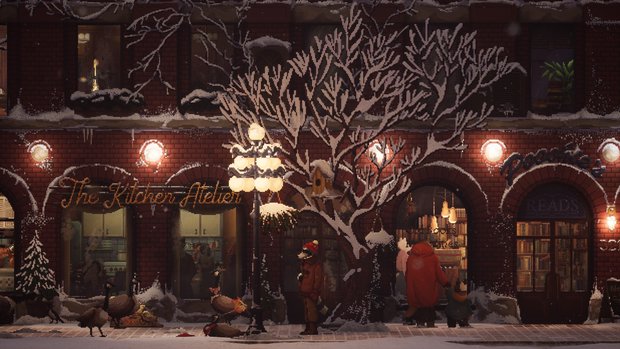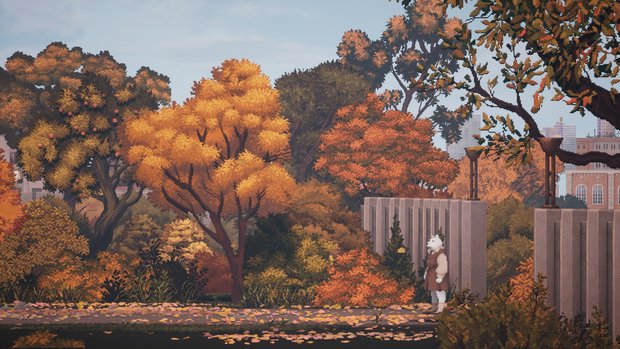Tails Noir Preludes review

- 0 Comments
Intimate branching animal anthology is a winner
Note: Since time of writing, the game's title has been changed from Tails: The Backbone Preludes to Tails Noir Preludes. Only the title has been altered here; the rest of the review is based on the original version of the game.
Branching narratives are a great way to draw players in, giving us choices that actually matter so we can feel the story is at least partly our own. Usually, though, only their designers get bird’s-eye views of the treelike structures of weaving possibilities while we blindly wander the uncharted woods. Eggnut's Tails: The Backbone Preludes does the exact opposite: it puts clear diagrams of the narrative strands front and centre, complete with helpful notes as to which decisions are pivotal. As a prequel to the original Backbone set anywhere between a few years and a couple of decades earlier, we already know where its narratives must end, but the soulful storytelling and wealth of small details make the journey more intriguing than the destination anyway. It's slow-paced and nearly puzzle-free, but it also presents some of the most delicately heartfelt explorations of the human condition I've ever seen.
For those who haven't played Backbone, it takes place in a postapocalyptic Vancouver that's home to a bustling community of anthropomorphic animals, such as the foxy investigative reporter Renee, the powerful bear gangster Clarissa, and the raccoon investigator Howard, a film noir gumshoe complete with long raincoat, droll comebacks, and tragic private life. What starts as a routine missing person case spirals out of control until events take a sci-fi twist that threatens to shake the foundations of society. And yet the big ideas are really just the backdrop for telling smaller, more intimate stories. Howard struggles to be taken seriously in a society that sees raccoons as the lowest of the low, while Renee tries to make her way in a man's world and Clarissa must play power politics with her ape overlords. Scientists tell themselves they're just doing their jobs as they experiment on the weak and helpless and policemen look the other way as the rich get away with murder, while veterans with thousand-yard stares hang out in a homeless camp by the river.
Tails takes this focus on small, everyday moments and runs with it. For the most part, rather than dwelling on the journey leading directly to Backbone, it dives into the crucial events that made its lead characters who they are: Howard's early years as a photography student, a six-month spell during which Renee gets her start as a serious reporter, and Clarissa's ascent (or descent) from innocent seven-year-old into running the family business over the course of two decades. These three stories stand alone, neither intersecting with each other nor really with later happenings. Only one of the four strands, centred on dogged scientist Eli's work at a remote desert research camp, has any direct bearing on the first game's plot, and even then it's at least as concerned with his struggles with isolation and the potentially nefarious bureaucracy in charge of the project as with his actual findings.

Also making a return are the lovely pixel art and moody soundtrack that made its predecessor so atmospheric. The diverse side-scrolling locations are drawn in exquisite detail and absolutely packed with life: waves lap against the shore, trams go clanging by, and pedestrians stroll past the warmly lit windows of Christmassy Gastown as snow swirls. Renee's shadow falls across the furniture as she turns on the light, and raindrops distort the views through shop windows. As we hop from Howard's dorm room to Renee's apartment, and from the dunes around Eli's tent to the industrial wasteland surrounding Clarissa's latest illicit meeting, it's an absolutely stunning artistic showcase. That said, perhaps because of the love and care that have been poured into every scene, each individual area is pretty small, though this fits with the low-key, tightly focused stories.
The melancholy ambience is reinforced by a blend of downtempo doom jazz, folksy electric guitars, and some north African-inspired motifs for Eli. Howard's dorm does occasionally get a bit funky, but otherwise you're left with a powerful sense of sadness and nostalgia. The characters aren't fully voiced (possibly because of the sheer volume of dialogue), but they do occasionally grunt, laugh, or utter the odd word to convey the emotions behind what they’re saying. For me this worked well, in that it set the tone while still leaving me free to read through the discussions at my own speed.
That's just as well, because everyone has a lot to talk about. Backbone was already quite dialogue-heavy, but here it takes centre stage, with other activities only mixed in once in a while for a change of pace. Even the objectives generally revolve around gathering information and engaging in conversation, with just a couple of more traditional object manipulation tasks included. Instead, you talk with other characters, build relationships and guide each protagonist's choices. Occasionally, however, convincing someone of your views or getting them to do what you want is involved enough to qualify as a (sometimes quite tricky) puzzle. As in life, though, if things don't go quite the way you want, you'll just have to live with the consequences. (You could go back to the start of a recent chapter segment via one of three automatic save slots or fire up a manual save from any other point you like, but that somewhat misses the point.)

Early on, you also get the choice of one of three traits for each character. For example, Clarissa can be cunning, ambitious, or powerful, each of which opens up alternate avenues later on. This is an interesting idea, but in practice the variations are subtle, simply accessing new dialogue options that occasionally allow you to tackle tasks in different ways. Then again, the differences you encounter as you navigate the game's many story highways and byways are also fairly subtle, changing small details rather than broad swaths of the narrative.
Conversations are a multiple-choice affair, taking place in a panel overlaid on the current scene so you can see the characters' reactions closer up as you talk. It looks a lot like an instant message window, just with numbered responses instead of an input box. In between chats, you walk around side-scrolling areas, with icons popping up as you pass items or people of interest to indicate that you can examine or talk to them. Once in a while you're also drawn into a mini-game that has you reorganising shelves or washing dishes. As you might imagine by now, these are more about giving characters a space to reminisce or ruminate than performing the tasks themselves.
Aside from the finale, the choices you make are all about changing and cementing relationships, not altering the actual course of events in any significant way; they don't change what happens so much as how and why it does. It matters whether Clarissa stands up to her abusive father and weathers his rage or meekly gives in to him, but the effects lie hidden under the surface for many years. Likewise, Howard's late-night discussions with his roommate Larry impact him deeply, but you wouldn't know it by their careless banter. To help understand how choice and consequene are connected, between scenes you’re given a glimpse behind the curtain and shown maps of each character’s decision points, with the path you’ve chosen wending its way down from one seemingly small but critical moment to another.

In other hands, without brain-teasing puzzles, startling plot twists, or much in the way of action, the result could have been bland and dull. Instead, the peaceful, reflective atmosphere here just brings the quietly powerful stories to the fore. The game captures perfectly those moments when little is said but everything shifts, such as (in Renee's case) when you know your marriage is over. If this all sounds like serious stuff, well, it is. The mood is leavened here and there, as Howard goofs around with his roommate or Renee comments sarcastically about the latest politician to get a golden handshake, but these are still the stories of people going through challenging times and there's no attempt to shy away from that.
Conversations flow naturally, and I quickly found myself both reflecting on the nuances of different possible responses (should I say "Sure" or just nod my head to convey that I'm giving in reluctantly?) and impressed at how my choices elicited similarly shaded reactions. Importantly, even though you're making decisions for the four protagonists, you can only influence them, not make them act out of character. You can push them one way or another, but not somewhere they don't want to go.
With all those branching paths to explore, Tails is designed to be a highly replayable experience. Spread over four acts, each further split into four segments focusing on the respective four main characters in turn, a single playthrough takes around four hours. However, in between segments you can explore where each of them is in their web of possibilities, and after completing the game you can see in full what happened throughout, encouraging you to go back and experiment with other options. After playing through twice, I still haven't seen everything, especially some of the more tricky-to-navigate avenues. Again, though, the details and endings change but not the big picture, so you won't miss any big scenes by just playing once. Playing again is, like many a time travel story, mostly a chance to go back and try to fix your mistakes, and find out if they were actually mistakes in the first place.
Final Verdict
For all its sci-fi trappings and anthropomorphic cast, Tails: The Backbone Preludes is predominantly a fascinating study of the everyday struggles of life. Setting the mood with its gorgeous pixel art and downtempo soundtrack, it's hard not to be entranced by the intricately realised characters and their naturalistic conversations. Where Backbone wrapped its moving storytelling in a more traditional adventure, Tails is free of those gamey shackles, allowing the characters and narratives to really soar. Here the only puzzles lie in navigating difficult relationships, and the result is a refreshingly different, highly involving experience.
Hot take
Tails: The Backbone Preludes is full of living, breathing characters who, for all their fur and tails, have to make some very human choices. Beautiful and mournful, it may be light on gameplay but will draw you into its web of subtle decisions that makes for more than just one compelling playthrough.
Pros
- Delightful pixel art and atmospheric jazz soundtrack
- Rounded, believable characters
- Relatable, heartfelt stories
- Nuanced conversations driven by subtle cues
Cons
- Not much to do aside from talk
- Small areas to explore and each playthrough is relatively short
Peter played Tails: The Backbone Preludes on PC using a review code provided by the game's publisher.









0 Comments
Want to join the discussion? Leave a comment as guest, sign in or register.
Leave a comment